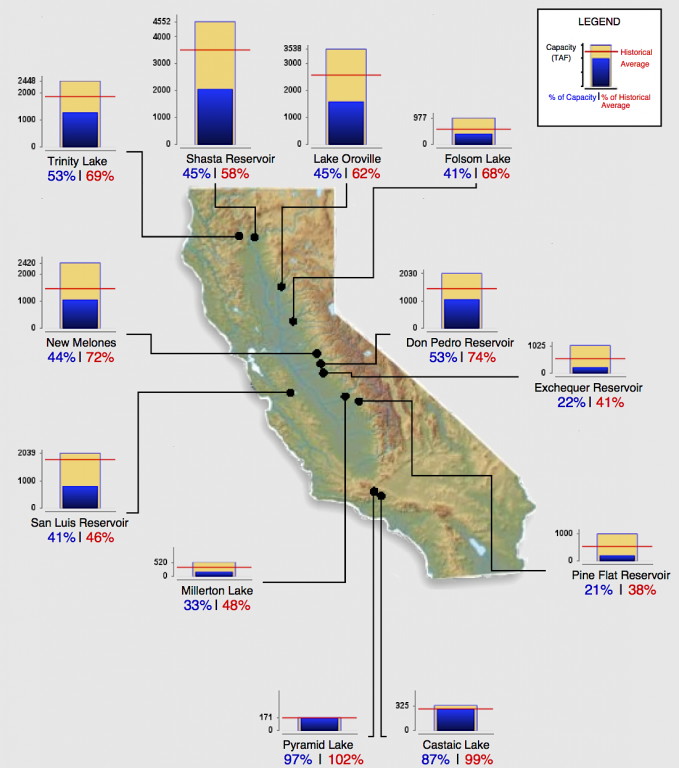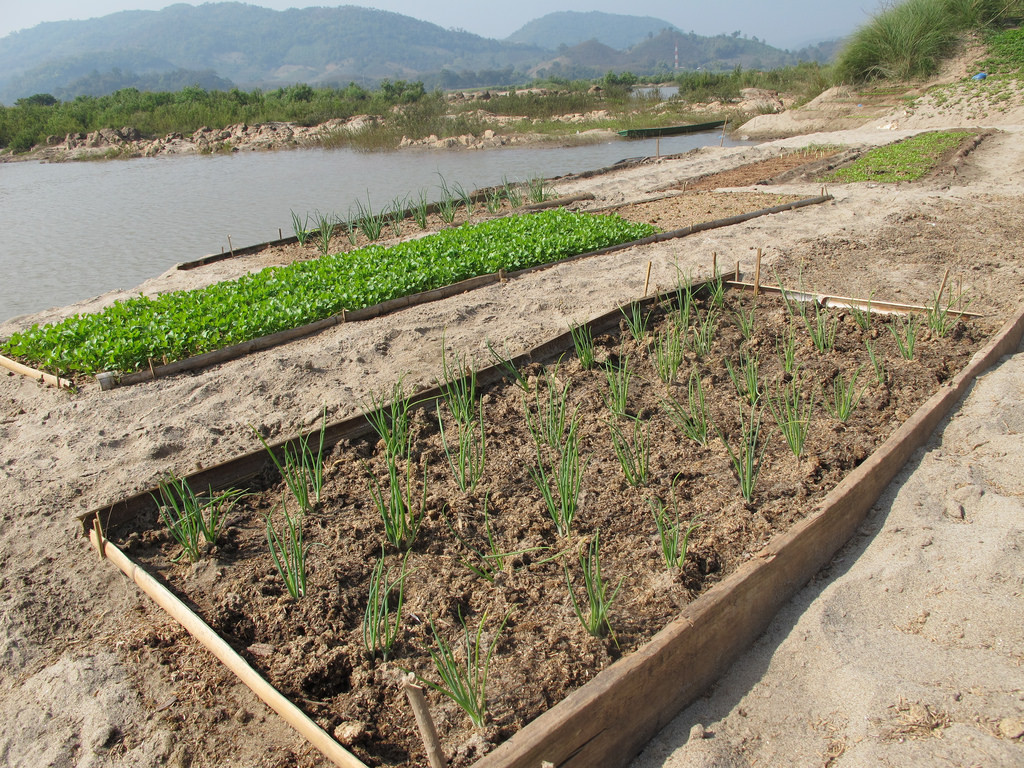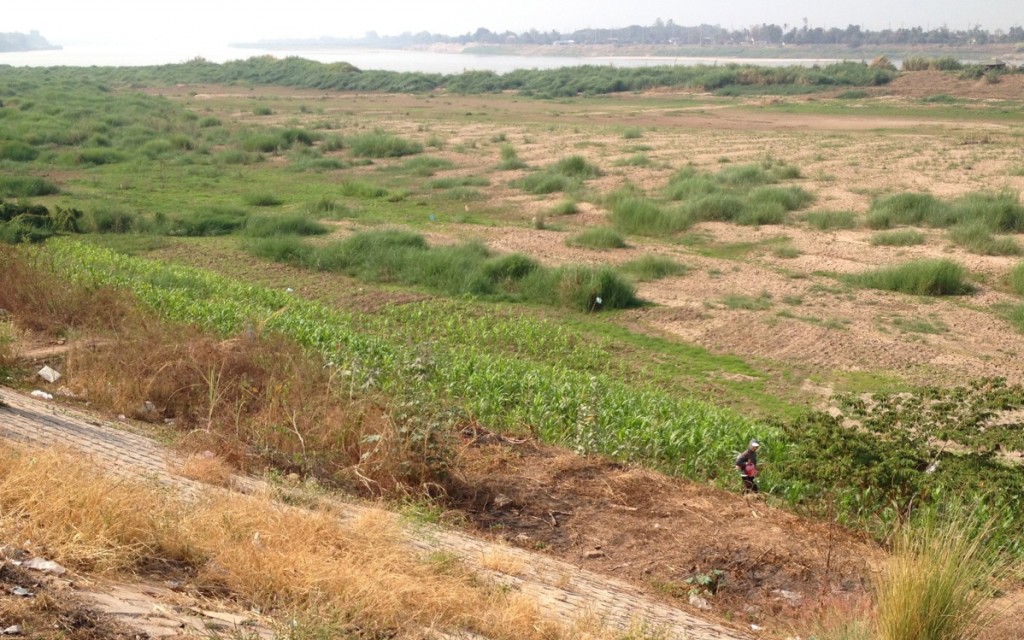|
|
|
March 24, 2014
In recognition of World Water Day, we thought it relevant to revisit the drought situation in California. Although we have received a dose of precipitation over the last couple of weeks, it has done very little to curb the state's drought status. According to the United States Drought Monitor, 93% of the state is still in severe drought or worse, but now 22% of the state has been downgraded to an "exceptional drought," the worst classification. Exceptional droughts are associated with widespread crop and pasture losses and shortages of water in reservoirs, streams and wells, which create water emergencies.
Over the past month a series of storms delivered rain and snow across the Sierra Nevada, but certainly not enough to ease drought concerns. The Northern Sierra 8-Station Index has improved to 53% of average, slightly higher than the two driest water years in recent history (1923-1924 and 1976-1977). The San Joaquin Index remains slightly below the record driest years, with just 42% of average precipitation.
 Major California reservoir storage on March 18, 2014 (courtesy DWR). Major California reservoir storage on March 18, 2014 (courtesy DWR).
While the recent storms have increased storage in some reservoirs like Folsom Lake, now at 68% of average, most reservoirs are well below historical averages. The largest water reservoir in the state is the Sierra snowpack. Snow water equivalents are only 17% of average for the Northern Sierra region, 32% for the Central Sierra region, and 29% in the Southern Sierra region. Statewide, the water equivalent of the snowpack is 27% of average and 26% of the April 1 st average. This means that mountain runoff that normally peaks in late June will come earlier this year and will bring much less water to our reservoirs.
When we last reported on the California drought (see Extreme drought by the numbers), we highlighted tree ring reconstructions that point to long periods of extreme historic droughts. Just last month, the California Department of Water Resources released a report called Klamath/San Joaquin/Sacramento Hydroclimatic Reconstructions from Tree Rings. It confirms the results of earlier studies that we previously reported, showing there have been past dry periods up to decades in length.
 Oceanic Niņo Index (ONI): Red bars indicate warm conditions in the equatorial Pacific, while blue bars indicate cool conditions (courtesy NOAA) Oceanic Niņo Index (ONI): Red bars indicate warm conditions in the equatorial Pacific, while blue bars indicate cool conditions (courtesy NOAA)
However, a change in the weather pattern may be on the horizon. The National Oceanic and Atmospheric Administration (NOAA) Climate Prediction Center has recently forecasted a 50% chance of El Niņo conditions developing by August of this year. If this occurs, we may be in store for drought-ending rainfall, but there are no guarantees. In four of the six strong El Niņo years since 1951, rainfall between Bakersfield and the Bay Area was at least 140% of normal, including 1982-83 when extensive flooding occurred. If a moderate El Niņo occurs, rainfall may be at or below normal. For example, in 2002 precipitation was 103% of normal, but in 1986 it was just 60% of normal. With the odds at no better than a coin toss for an El Niņo occurring, it is probably wisest for us to continue to conserve water with the expectation that drought conditions will continue into next year. |
|
 |
|
Recent Blog Posts
|
Riverside gardens 
The months of March and April are the height of the dry season in Laos. No rain breaks the persistent heat and the air is hazy with sun and dust. During this time, the Mekong River is at its lowest water level of the year, shrinking to a fraction of its former self and exposing vast tracts of sandy bank. This dry period of low water is one of two distinct faces of the river that change with the seasons. It contrasts sharply with the wet season of May to October, when the river floods in the rainy monsoons and swells its banks.

Though this contraction of water might seem dire, both the wildlife and people of the Mekong have adapted to the seasonal pulse of water that dramatically rises and falls over the course of the year (see Life afloat). One sign of this cyclical lifestyle is the riverside gardens that sprout up along the fertile riverbank soil when the waters recede. People plant these gardens with crops like corn and potatoes, onions and herbs. Gardens are a common feature of village life (top photo), and an important source of supplementary food. They can even be found along the riverbank in the capital city of Vientiane at this time of year (lower photo). This dynamic culture of planting is accustomed to the swelling and shrinking of the river... Read more >
A room with a view
 Nesting boxes are a common sight near the areas we work. Many of these boxes are installed for the conservation of species such as the Wood Duck (Aix sponsa) that have lost habitat, often due to human encroachment. On this day, our field technicians happened to observe a Great Horned Owl (Bubo virginianus) occupying one of these sky-high condos. Farmers and vineyard owners sometimes take it upon themselves to build these boxes to attract owls to their properties, where the owls act as "cats with wings," preying on smaller animals that may damage crops... Read more Nesting boxes are a common sight near the areas we work. Many of these boxes are installed for the conservation of species such as the Wood Duck (Aix sponsa) that have lost habitat, often due to human encroachment. On this day, our field technicians happened to observe a Great Horned Owl (Bubo virginianus) occupying one of these sky-high condos. Farmers and vineyard owners sometimes take it upon themselves to build these boxes to attract owls to their properties, where the owls act as "cats with wings," preying on smaller animals that may damage crops... Read more
|
|
|
|
IN THE NEWS: Recent stories you might have missed...
|
Voices of the drought: Hatcheries, where will the fish go?
Valley Public Radio
There are over 1.5 million fish at the San Joaquin Fish Hatchery at the base of Friant Dam, which holds back Millerton Lake on the border of Fresno and Madera Counties. Greg Paape runs the hatchery for the California Department of Fish and Wildlife. Today he's inspecting the health of rainbow trout that he and his team have watched grow from eggs to four to six pounders... Read more >
|
New study predicts fewer rainy days in CA's future
 Southern California Public Radio Southern California Public RadioIt's drier days ahead for California, according to a new study from the Scripps Institution of Oceanography. The researchers used a new way of analyzing computer models to predict rain levels across the globe. They found that by the end of the century, California could see as many as ten more dry days per year. The study's lead author Suraj Polade said California should expect much more variation in it's weather as well... Read more >
|
Hottest winter ever: California breaks record
Marin News

You probably didn't need that warm coat much as California emerged Thursday from its hottest winter in recorded history. The state broke its warm winter record by a whopping eight-tenths of a degree, which, according to the National Oceanic and Atmospheric Administration, is nothing to sneeze at. Leave it to weather-data crunchers to find a way of calculating a record high that produces what seems like a middling number... Read more >
|
New system eases lamprey passage
The Columbian
 Pacific lamprey will now be able to more easily swim past the McNary Lock and Dam on the Columbia River. Dam managers have installed a new lamprey passage system - the first of its kind for the toothy, eel-like fish. Pacific lamprey numbers have dropped dramatically in the past 25 years. No one is really sure why - but fish biologists suspect difficulty swimming upstream is partly to blame... Read more > Pacific lamprey will now be able to more easily swim past the McNary Lock and Dam on the Columbia River. Dam managers have installed a new lamprey passage system - the first of its kind for the toothy, eel-like fish. Pacific lamprey numbers have dropped dramatically in the past 25 years. No one is really sure why - but fish biologists suspect difficulty swimming upstream is partly to blame... Read more >
|
Robot eyes protecting from above: Drones and ocean conservation
National Geographic

A robust and healthy ocean is the lifeblood for our planet, sustaining life through interconnected ecosystems worldwide. Unfortunately, as a result of global industrial overfishing pressure, many of these ecosystems have shown signs of rapid deterioration. This is particularly bad in the high seas, the part of the oceans that lie beyond 200-miles off the coast, where we are facing a tragedy of the commons... Read more >
|
|
|
|
|
|